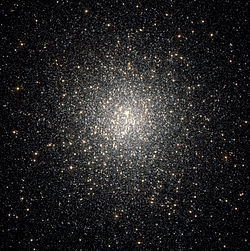NGC 2808
| NGC 2808 | |
|---|---|
 A Hubble Space Telescope (HST) image of NGC 2808 | |
| Observation data (J2000 epoch) | |
| Class | I[1] |
| Constellation | Carina |
| Right ascension | 09h 12m 03.10s[2] |
| Declination | –64° 51′ 48.6″[2] |
| Distance | 31.3 kly (9.6 kpc)[3] |
| Apparent magnitude (V) | 6.2[4] |
| Apparent dimensions (V) | 13.8′[4] |
| Physical characteristics | |
| Mass | 1.42×106[3] M☉ |
| Metallicity | = –1.14[3] dex |
| Estimated age | 10.2 Gyr[5] |
| Other designations | GCl 13, Melotte 95[6] |
NGC 2808 is a globular cluster[6] in the constellation Carina. The cluster currently belongs to the Milky Way, although it was likely stolen from a dwarf galaxy that collided with the Milky Way. NGC 2808 is one of the Milky Way's most massive clusters, containing more than a million stars. It is estimated to be 12.5 billion years old.
The cluster is being disrupted by the galactic tide, trailing a long tidal tail.[7]
Star generations
[edit]It had been thought that NGC 2808, like typical globular clusters, contains only one generation of stars formed simultaneously from the same material. In 2007, a team of astronomers led by Giampaolo Piotto of the University of Padua in Italy investigated Hubble Space Telescope images of NGC 2808 taken in 2005 and 2006 with Hubble's Advanced Camera for Surveys. Unexpectedly, they found that this cluster is composed of three generations of stars, all born within 200 million years of the formation of the cluster.[8]
Astronomers have argued that globular clusters can produce only one generation of stars, because the radiation from first generation stars would drive the residual gas not consumed in the first star generation phase out of the cluster. However, the great mass of a cluster such as NGC 2808 may suffice to gravitationally counteract the loss of gaseous matter. Thus, a second and a third generation of stars may form.
An alternative explanation for the three star generations of NGC 2808 is that it may actually be the remnant core of a dwarf galaxy that collided with the Milky Way, called the Sausage Galaxy.[9]
See also
[edit]- Messier 54 and Messier 79, two other possibly extragalactic globular clusters
- Omega Centauri
References
[edit]- ^ Shapley, Harlow; Sawyer, Helen B. (August 1927), "A Classification of Globular Clusters", Harvard College Observatory Bulletin, 849 (849): 11–14, Bibcode:1927BHarO.849...11S
- ^ a b Goldsbury, Ryan; et al. (December 2010), "The ACS Survey of Galactic Globular Clusters. X. New Determinations of Centers for 65 Clusters", The Astronomical Journal, 140 (6): 1830–1837, arXiv:1008.2755, Bibcode:2010AJ....140.1830G, doi:10.1088/0004-6256/140/6/1830, S2CID 119183070.
- ^ a b c Boyles, J.; et al. (November 2011), "Young Radio Pulsars in Galactic Globular Clusters", The Astrophysical Journal, 742 (1): 51, arXiv:1108.4402, Bibcode:2011ApJ...742...51B, doi:10.1088/0004-637X/742/1/51, S2CID 118649860
- ^ a b "Data for NGC 2808". NGC/IC Project. Archived from the original on 15 January 2013. Retrieved 19 November 2013.
- ^ Koleva, M.; et al. (April 2008), "Spectroscopic ages and metallicities of stellar populations: validation of full spectrum fitting", Monthly Notices of the Royal Astronomical Society, 385 (4): 1998–2010, arXiv:0801.0871, Bibcode:2008MNRAS.385.1998K, doi:10.1111/j.1365-2966.2008.12908.x, S2CID 17571531
- ^ a b "NGC 2808". SIMBAD. Centre de données astronomiques de Strasbourg. Retrieved 2007-05-07.
- ^ Carballo-Bello, Julio A.; Martínez-Delgado, David; Navarrete, Camila; Catelan, Márcio; Muñoz, Ricardo R.; Antoja, Teresa; Sollima, Antonio (2017), "Tails and streams around the Galactic globular clusters NGC 1851, NGC 1904, NGC 2298 and NGC 2808", Monthly Notices of the Royal Astronomical Society, 474: 683–695, arXiv:1710.08927, doi:10.1093/mnras/stx2767
- ^ Piotto, G.; et al. (May 2007). "A Triple Main Sequence in the Globular Cluster NGC 2808". The Astrophysical Journal. 661 (1): L53 – L56. arXiv:astro-ph/0703767. Bibcode:2007ApJ...661L..53P. doi:10.1086/518503. S2CID 18691514.
- ^ C., Myeong, G.; W., Evans, N.; V., Belokurov; L., Sanders, J.; E., Koposov, S. (2018). "The Sausage Globular Clusters". The Astrophysical Journal. 863 (2): L28. arXiv:1805.00453. Bibcode:2018ApJ...863L..28M. doi:10.3847/2041-8213/aad7f7. S2CID 67791285.
{{cite journal}}: CS1 maint: multiple names: authors list (link)
External links
[edit] Media related to NGC 2808 at Wikimedia Commons
Media related to NGC 2808 at Wikimedia Commons

![{\displaystyle {\begin{smallmatrix}\left[{\ce {Fe}}/{\ce {H}}\right]\end{smallmatrix}}}](https://wikimedia.org/api/rest_v1/media/math/render/svg/4c0821bd80891e071c08e7c7ee8e022baedf522c)